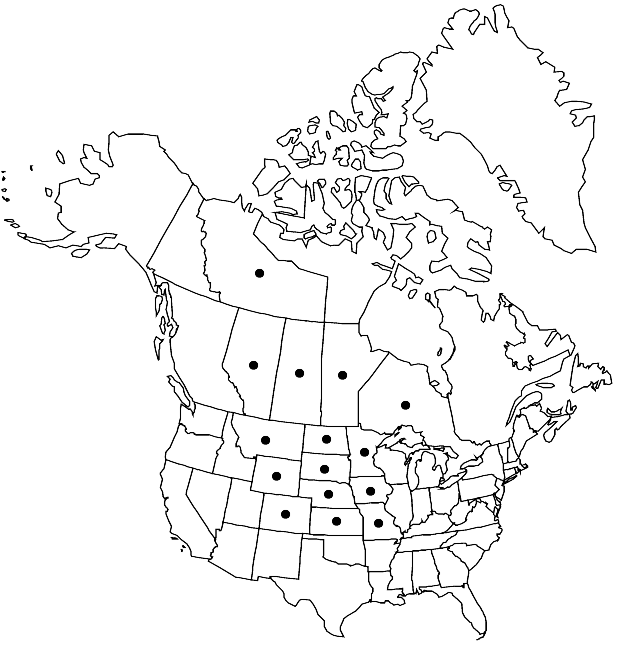Difference between revisions of "Salix famelica"
Harvard Pap. Bot. 12: 361. 2007.
FNA>Volume Importer |
imported>Volume Importer |
||
| Line 61: | Line 61: | ||
|publication year=2007 | |publication year=2007 | ||
|special status= | |special status= | ||
| − | |source xml=https:// | + | |source xml=https://bibilujan@bitbucket.org/aafc-mbb/fna-data-curation.git/src/bb6b7e3a7de7d3b7888a1ad48c7fd8f5c722d8d6/coarse_grained_fna_xml/V7/V7_125.xml |
|genus=Salix | |genus=Salix | ||
|subgenus=Salix subg. Vetrix | |subgenus=Salix subg. Vetrix | ||
Revision as of 23:52, 27 May 2020
Shrubs or trees, 1.5–7 m. Stems: branches yellow, yellow-gray, or yellow-brown, not glaucous, glabrous (tomentose at nodes) or pubescent; branchlets yellow-brown or red-brown, (sometimes weakly glaucous with sparkling wax crystals), usually glabrous, sometimes pilose, pubescent, or moderately densely villous. Leaves: stipules rudimentary or foliaceous on early ones, foliaceous on late ones, apex acute or rounded; petiole convex to flat, or shallowly grooved adaxially, 3–27 mm, puberulent, pubescent, tomentose, velvety, or glabrous adaxially; largest medial blade (sometimes hemiamphistomatous), narrowly oblong, narrowly elliptic, or lanceolate, 28–116 × 10–30 mm, 2.6–3.5–7 times as long as wide, base subcordate, convex, or rounded, margins flat or slightly revolute, serrate, shallowly serrulate or crenulate, apex acuminate to acute, abaxial surface glabrous, pilose, or pubescent, midribs hairy, adaxial dull or slightly glossy, glabrous, pilose, sparsely long-silky, or tomentose, midribs hairy; proximal blade margins entire or shallowly serrulate; juvenile blade reddish or yellowish green, glabrous, pilose, or villous abaxially, hairs white. Catkins: staminate flowering before or just before leaves emerge, pistillate as leaves emerge; staminate slender, stout, or subglobose, 15–44 × 8–14 mm, flowering branchlet 0.5–4 mm; pistillate loosely or moderately densely flowered, slender or stout, 16–74(–115 in fruit) × 7–15 mm, flowering branchlet 0.5–9 mm; floral bract dark brown or tawny, 0.8–1.6 mm, apex rounded or convex, abaxially hairy throughout or proximally, hairs straight or wavy. Staminate flowers: adaxial nectary narrowly oblong, oblong, or flask-shaped, 0.8–1 mm; filaments distinct or connate less than 1/2 their lengths, glabrous; anthers yellow or purple turning yellow, (ellipsoid), 0.5–0.7 mm. Pistillate flowers: adaxial nectary 0.6–0.8 mm, shorter than stipe; stipe 0.7–2.4(–2.75) mm; ovary pyriform or obclavate, glabrous, beak sometimes slightly bulged below styles; ovules 12–18 per ovary; styles 0.2–0.6 mm; stigmas flat, abaxially non-papillate with rounded tip, or 2 plump lobes, 0.12–0.22–0.32 mm. Capsules 5–6 mm.
Phenology: Flowering mid Apr-mid Jun.
Habitat: Riparian willow thickets on silty, sandy-clay, gravelly, or bouldery banks and floodplains, sand dunes, alluvial fans, wet meadows, rich fens, prairie depressions, balsam poplar thickets
Elevation: 0-2000 m
Distribution

Alta., Man., N.W.T., Ont., Sask., Colo., Iowa, Kans., Minn., Mo., Mont., Nebr., N.Dak., S.Dak., Wyo.
Discussion
Salix famelica is a Great Plains taxon that was recognized by R. D. Dorn (1995) as S. lutea var. famelica. It is separable from the other members of sect. Cordatae mainly by its yellow-brown to gray-brown branches and contrasting red-brown branchlets. It is recognized here as a species because, although it intergrades with other taxa in the complex, it has a relatively large, allopatric distribution.
Hybrids:
Salix famelica forms natural hybrids with S. candida, S. eriocephala, S. petiolaris, and S. pseudomonticola.
Salix famelica × S. petiolaris resembles S. famelica in having foliaceous stipules on late leaves and yellow-brown branches, and S. petiolaris in having ferruginous hairs on juvenile leaves. It is intermediate in leaf shape, in having stipules rudimentary on early leaves, and in having ovaries with patches of hairs at the base.
Salix famelica × S. pseudomonticola: Saskatchewan specimens combine the characters of the parental species.
Selected References
None.